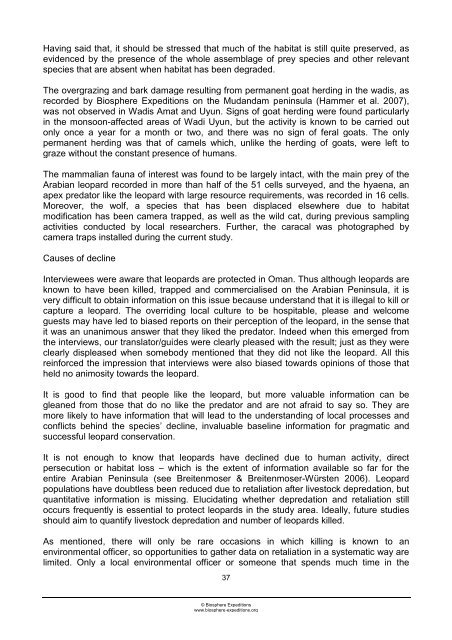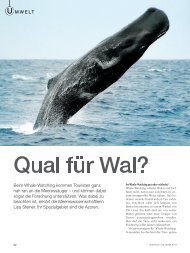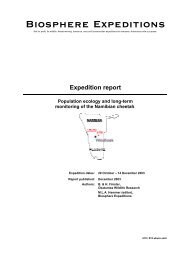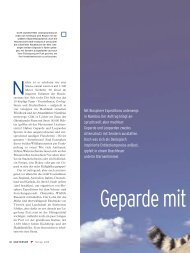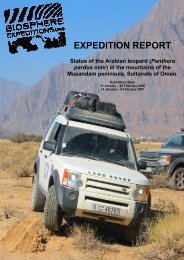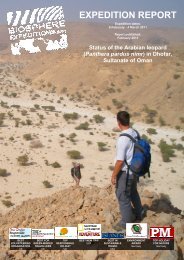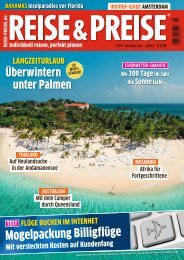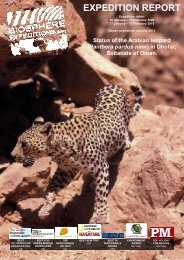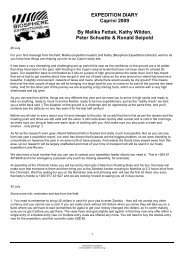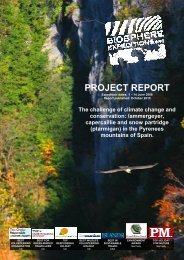Status of the Arabian leopard Panthera pardus nimr - Biosphere ...
Status of the Arabian leopard Panthera pardus nimr - Biosphere ...
Status of the Arabian leopard Panthera pardus nimr - Biosphere ...
Create successful ePaper yourself
Turn your PDF publications into a flip-book with our unique Google optimized e-Paper software.
Having said that, it should be stressed that much <strong>of</strong> <strong>the</strong> habitat is still quite preserved, as<br />
evidenced by <strong>the</strong> presence <strong>of</strong> <strong>the</strong> whole assemblage <strong>of</strong> prey species and o<strong>the</strong>r relevant<br />
species that are absent when habitat has been degraded.<br />
The overgrazing and bark damage resulting from permanent goat herding in <strong>the</strong> wadis, as<br />
recorded by <strong>Biosphere</strong> Expeditions on <strong>the</strong> Mudandam peninsula (Hammer et al. 2007),<br />
was not observed in Wadis Amat and Uyun. Signs <strong>of</strong> goat herding were found particularly<br />
in <strong>the</strong> monsoon-affected areas <strong>of</strong> Wadi Uyun, but <strong>the</strong> activity is known to be carried out<br />
only once a year for a month or two, and <strong>the</strong>re was no sign <strong>of</strong> feral goats. The only<br />
permanent herding was that <strong>of</strong> camels which, unlike <strong>the</strong> herding <strong>of</strong> goats, were left to<br />
graze without <strong>the</strong> constant presence <strong>of</strong> humans.<br />
The mammalian fauna <strong>of</strong> interest was found to be largely intact, with <strong>the</strong> main prey <strong>of</strong> <strong>the</strong><br />
<strong>Arabian</strong> <strong>leopard</strong> recorded in more than half <strong>of</strong> <strong>the</strong> 51 cells surveyed, and <strong>the</strong> hyaena, an<br />
apex predator like <strong>the</strong> <strong>leopard</strong> with large resource requirements, was recorded in 16 cells.<br />
Moreover, <strong>the</strong> wolf, a species that has been displaced elsewhere due to habitat<br />
modification has been camera trapped, as well as <strong>the</strong> wild cat, during previous sampling<br />
activities conducted by local researchers. Fur<strong>the</strong>r, <strong>the</strong> caracal was photographed by<br />
camera traps installed during <strong>the</strong> current study.<br />
Causes <strong>of</strong> decline<br />
Interviewees were aware that <strong>leopard</strong>s are protected in Oman. Thus although <strong>leopard</strong>s are<br />
known to have been killed, trapped and commercialised on <strong>the</strong> <strong>Arabian</strong> Peninsula, it is<br />
very difficult to obtain information on this issue because understand that it is illegal to kill or<br />
capture a <strong>leopard</strong>. The overriding local culture to be hospitable, please and welcome<br />
guests may have led to biased reports on <strong>the</strong>ir perception <strong>of</strong> <strong>the</strong> <strong>leopard</strong>, in <strong>the</strong> sense that<br />
it was an unanimous answer that <strong>the</strong>y liked <strong>the</strong> predator. Indeed when this emerged from<br />
<strong>the</strong> interviews, our translator/guides were clearly pleased with <strong>the</strong> result; just as <strong>the</strong>y were<br />
clearly displeased when somebody mentioned that <strong>the</strong>y did not like <strong>the</strong> <strong>leopard</strong>. All this<br />
reinforced <strong>the</strong> impression that interviews were also biased towards opinions <strong>of</strong> those that<br />
held no animosity towards <strong>the</strong> <strong>leopard</strong>.<br />
It is good to find that people like <strong>the</strong> <strong>leopard</strong>, but more valuable information can be<br />
gleaned from those that do no like <strong>the</strong> predator and are not afraid to say so. They are<br />
more likely to have information that will lead to <strong>the</strong> understanding <strong>of</strong> local processes and<br />
conflicts behind <strong>the</strong> species’ decline, invaluable baseline information for pragmatic and<br />
successful <strong>leopard</strong> conservation.<br />
It is not enough to know that <strong>leopard</strong>s have declined due to human activity, direct<br />
persecution or habitat loss – which is <strong>the</strong> extent <strong>of</strong> information available so far for <strong>the</strong><br />
entire <strong>Arabian</strong> Peninsula (see Breitenmoser & Breitenmoser-Würsten 2006). Leopard<br />
populations have doubtless been reduced due to retaliation after livestock depredation, but<br />
quantitative information is missing. Elucidating whe<strong>the</strong>r depredation and retaliation still<br />
occurs frequently is essential to protect <strong>leopard</strong>s in <strong>the</strong> study area. Ideally, future studies<br />
should aim to quantify livestock depredation and number <strong>of</strong> <strong>leopard</strong>s killed.<br />
As mentioned, <strong>the</strong>re will only be rare occasions in which killing is known to an<br />
environmental <strong>of</strong>ficer, so opportunities to ga<strong>the</strong>r data on retaliation in a systematic way are<br />
limited. Only a local environmental <strong>of</strong>ficer or someone that spends much time in <strong>the</strong><br />
37<br />
© <strong>Biosphere</strong> Expeditions<br />
www.biosphere-expeditions.org


